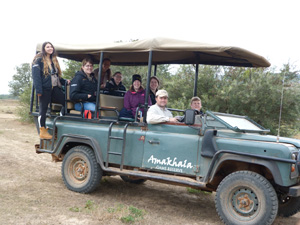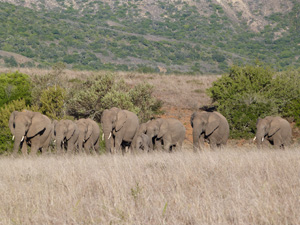This spring, 13 students from ะยผำฦยม๙บฯฒสฟชฝฑึฑฒฅ's Faculty of Agriculture traveled to the Eastern Cape of South Africa for the first ever African Wildlife Ecology course, a three week intensive credit course introduced as part of the new Bioveterinary Science program. AWE was developed in partnership with the Wildlife & Reserve Management Research Group at Rhodes University, who also delivered the course content.
 โThis course was developed for our new degree in Bioveterinary Sciences, but more importantly it was developed because there is no better place to see and study ecology than in Africa,โ says Dr. Gray, Dean of the Faculty of Agriculture. โLarge predators, interaction between species, game migrations โ the African bush has it all.โ
โThis course was developed for our new degree in Bioveterinary Sciences, but more importantly it was developed because there is no better place to see and study ecology than in Africa,โ says Dr. Gray, Dean of the Faculty of Agriculture. โLarge predators, interaction between species, game migrations โ the African bush has it all.โ
Current students from the Animal Science and Pre-Veterinary Medicine programs were able to take AWE as an elective this spring. The group was accompanied by Dr. Janine Gray and Sarah Gatti-Yorke, instructors in the Department of Plant & Animal Sciences.
โIt was a very intensive program,โ says Andrew Greene, a third year Animal Science student. โAs soon as we arrived we started learning.โ
The course incorporated field research, lectures and practice in conservation and veterinary care. Students were also expected to complete an individual research project on something that interested them. Janessa Henry, a third year Animal Science student, focused on the diversity of hooved mammals in different types of habitat.
โMy project was on ungulate diversity in the thicket biome. I conducted my research over multiple game drives and it consisted of counting all of the animals I saw and classifying the vegetation type which I found them in,โ explains Janessa. โI really enjoyed going out on game drives and learning from the ranger as I collected my data. I chose this project because I had a real interest in the antelope species and wanted to do something that incorporated them.โ
 The group spent the first 12 days of their trip at the Amakhala Game Reserve, a privately-owned park sprawling over 18,000 acres that was once agricultural land. Here they went on regular game drives andย nature walks and took in several lectures and labs. Lecture topics spanned everything from the history of Amakhala to data collection techniques to the importance of vegetation types and densities, and were delivered by both Rhodes University faculty and Amakhala staff. The main instructor, Dr. Dan Parker of Rhodes University, provided guidance for the research projects along with Janine and Sarah.
The group spent the first 12 days of their trip at the Amakhala Game Reserve, a privately-owned park sprawling over 18,000 acres that was once agricultural land. Here they went on regular game drives andย nature walks and took in several lectures and labs. Lecture topics spanned everything from the history of Amakhala to data collection techniques to the importance of vegetation types and densities, and were delivered by both Rhodes University faculty and Amakhala staff. The main instructor, Dr. Dan Parker of Rhodes University, provided guidance for the research projects along with Janine and Sarah.
The group was exposed to many different species of wildlife while at Amakhala, including lions, rhinos, elephants, giraffes, zebras, wildebeests, kudu, warthogs, and assorted reptiles, small mammals and avian species. During their very first game drive, they witnessed a lion kill right before their eyes.
The lion kill was an educational example of a predator-prey relationship in the wild. Not only did the students get to see the lions make the kill, but they were also able to hear a few other species (including vervet monkeys and cape crows) give alarm calls to warn one another of the approaching predator. However, this wasnโt even the most exciting thing to happen to them during their stay at Amakhala.
Janessa and Andrew agree that the most exciting part of the trip was when they had the opportunity to work on a pair of white rhinos. Halfway through their stay at Amakhala, the students found out they would be helping to treat a male and female rhino pair the following day.
โDefinitely one of the most memorable and meaningful experiences for me was working on the rhino,โ says Andrew. โIโm looking to pursue a career in veterinary medicine, so getting hands-on experience with such a large animal will be directly applicable to my career going forward.โ
The rhinos were anesthetized by a veterinarian and the students were split into two groups to process them. Under supervision from the vets on hand, the teams of students were allowed to check the animalsโ pulse, administer medicine to them and monitor their respiration.
 The entire procedure took about an hour to complete. โI didnโt expect to have such a close encounter with such a large animal,โ says Janessa. โTo get to touch its skin and feel how powerful it really is was truly amazing. I will treasure this memory for life.โ
The entire procedure took about an hour to complete. โI didnโt expect to have such a close encounter with such a large animal,โ says Janessa. โTo get to touch its skin and feel how powerful it really is was truly amazing. I will treasure this memory for life.โ
After 12 days at Amakhala, filled with exciting discoveries, lots of learning, delicious food and more animals than they could count, the group moved on to Mountain Zebra National Park for two nights. Here they continued with game drives and hiking, having a chance to see some now familiar species as well as new species up close. National parks in South Africa only stock species which are native to that specific area, meaning there is a degree of diversity between parks. The students saw these differences firsthand between Mountain Zebra and Addo Elephant Park, their last stop before heading back to Canada.
Addo Elephant National Park is the third largest national park in South Africa, spanning roughly 450,000 acres and home to over 600 elephants. Here the group learned about elephant management and the positive and negative effects elephants can have on various aspects of a thicket biome, including vegetation and other species. Addo provided exceptional photo opportunities โ although these werenโt hard to come by at any point during the trip.
If youโd like to read more about the first group of African Wildlife Ecology students and their adventures, you can find their blog at .
Recent News
- MacRae Library Student Research poster competition
- Senator Colin Deacon recognizes Jolene MacEachern with King Charles III Coronation Medal
- AC graduates driving innovation and growth in the Dairy Industry with Lely North America
- Homecoming 2024 Photo Recap
- Hall of Fame inducts four new members
- 2024 Blue & Gold Awards presented
- Honouring Indigenous Knowledge: Community Food Systems in the Philippines
- Food Services Reading Week Hours โ November 11 โ 15, 2024.
